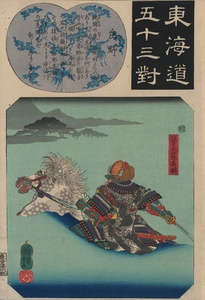| Method | Woodblock (nishiki-e) |
| Artist | Utagawa Kuniyoshi (1797-1861) |
| Published | 1845-46 |
| Dimensions | Ôban tate-e [~15.6 x 10.7 inches] |
| Notes |
Series: Tôkaidô gojûsan tsui: Fifty-three parallels for the Tôkaidô Road Signature: Ichiyûsai Kuniyoshi Artist seal: Kiri Publisher: Ibaya Senzaburô (Dansendô) Censor seal: Mura Reference: Schaap, Robert, Heroes and Ghosts (1998), pl.49, p.73. A dramatic scene showing the samurai commander Sasaki Shirô Takatsuna crossing the overflowing river Uji on the white horse, Ikezuki, Station 46, from Tôkaidô gojûsan tsui: Fifty-three parallels for the Tôkaidô Road, a series jointly designed by Hiroshige, Kunisada, and Kuniyoshi. The print shows Takatsuna at the centre of the scene, his back to the viewer, pulling on the reins of Ikezuki who is neck deep in the fast flowing water. Takatsuna wears an elaborately decorated suit of armour, his jinbaori, or surcoat over his back emblazoned with a depiction of a dragon. In the background the silhouette of the land and trees can be seen, the blue of the water merging in to the sky above. In this scene Takatsuna is racing Kajiwara Kagesue, a samurai in service to the Minamoto clan during the Genpei War, across the River Uji atop Shōgun Yoritomo's white horse, to be the first to fight at the 1184 battle of Uji. Sasaki Shirô Takatsuna (1160 - 1214) was a famous samurai commander in the Genpei War (1180 - 1185), the conflict between the Minamoto and Taira clans. Utagawa Kuniyoshi (1797-1861) joined the famous Utagawa School, then headed by the great master Toyokuni Utagawa (1769 - 1825) at the age of fourteen. According to other sources, he had been trained by Katsukawa Shuntei before this. Kuniyoshi achieved his commercial and artistic breakthrough in 1827 with the first six designs of the series The Hundred and Eight Heroes of the Suikoden. The series was about one hundred and eight rebels and honorary bandits, based on an old Chinese novel from the fourteenth century. The story was very popular in Japan. The artist continued with this pattern of success and concentrated on print subjects of warriors and heroes. He was even nicknamed Warrior Print Kuniyoshi. After being financially settled, he turned to other subjects - ghost stories, comic prints, landscapes, beautiful women and actor prints. The artist also tried his luck with another subject, natural life prints, showing animals like birds, fish and cats. These kinds of new subjects, like the landscape print, had first been made popular by Ando Hiroshige. Since the early 1840s, Kuniyoshi prints show some influence of western style painting and printmaking. The artist possessed a collection of western engraving prints. He admired them as much as the European Impressionist artists would admire Japanese woodblock prints later. Western influence can be found in Kuniyoshi prints in several ways: the use of the Western perspective, the way he designed clouds and the way he tried to show the effects of light and shadow. Condition: Binding holes to left side of sheet. Trimmed close to image on top edge. |
| Framing | mounted |
| Price | £650.00 |
| Stock ID | 53005 |

